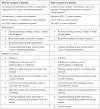Differences in the profiles of DSM-IV and DSM-5 alcohol use disorders: implications for clinicians
- PMID: 22974144
- PMCID: PMC3800556
- DOI: 10.1111/j.1530-0277.2012.01930.x
Differences in the profiles of DSM-IV and DSM-5 alcohol use disorders: implications for clinicians
Abstract
Background: Existing information on consequences of the DSM-5 revision for the diagnosis of alcohol use disorders (AUD) has gaps, including missing information critical to understanding implications of the revision for clinical practice.
Methods: Data from Wave 2 of the National Epidemiologic Survey on Alcohol and Related Conditions were used to compare AUD severity, alcohol consumption and treatment, sociodemographic and health characteristics, and psychiatric comorbidity among individuals with DSM-IV abuse versus DSM-5 moderate AUD and DSM-IV dependence versus DSM-5 severe AUD. For each pair of disorders, we additionally compared 3 mutually exclusive groups: individuals positive solely for the DSM-IV disorder, those positive solely for the DSM-5 disorder, and those positive for both.
Results: Whereas 80.5% of individuals positive for DSM-IV dependence were positive for DSM-5 severe AUD, only 58.0% of those positive for abuse were positive for moderate AUD. The profiles of individuals with DSM-IV dependence and DSM-5 severe AUD were almost identical. The only significant (p < 0.005) difference, more AUD criteria among the former, reflected the higher criterion threshold (≥ 4 vs. ≥ 3) for severe AUD relative to dependence. In contrast, the profiles of individuals with DSM-5 moderate AUD and DSM-IV abuse differed substantially. The former endorsed more AUD criteria, had higher rates of physiological dependence, were less likely to be White individuals and men, had lower incomes, were less likely to have private and more likely to have public health insurance, and had higher levels of comorbid anxiety disorders than the latter.
Conclusions: Similarities between the profiles of DSM-IV and DSM-5 AUD far outweigh differences; however, clinicians may face some changes with respect to appropriate screening and referral for cases at the milder end of the AUD severity spectrum, and the mechanisms through which these will be reimbursed may shift slightly from the private to public sector.
Copyright © 2012 by the Research Society on Alcoholism.
Figures
References
-
- American Psychiatric Association. Diagnostic and Statistical Manual of Mental Disorders. 4. American Psychiatric Association; Washington DC: 1994.
-
- Babor TF, Caetano R. The trouble with alcohol abuse: what are we trying to measure, diagnose, count and prevent? Addiction. 2008;103:1057–1059. - PubMed
-
- Babor TF. Substance, not semantics, is the issue: Comments on the proposed addiction criteria for DSM-V. Addiction. 2011;106:870–872. - PubMed
Publication types
MeSH terms
Grants and funding
LinkOut - more resources
Full Text Sources


